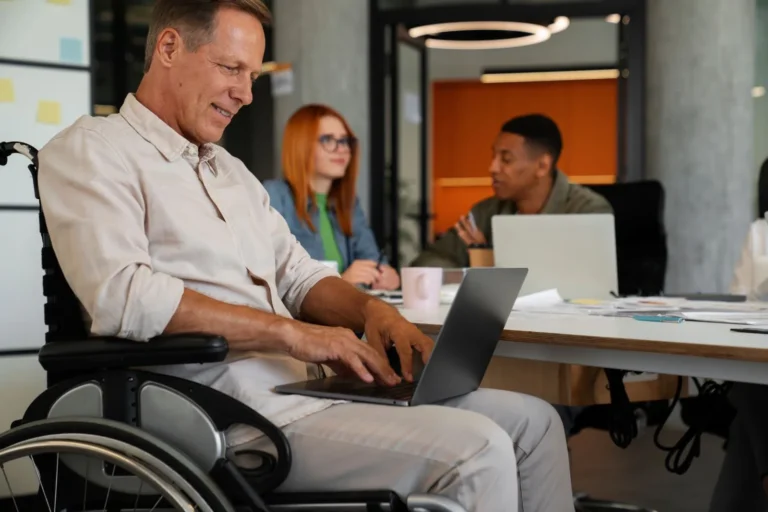Whiteboards have been the backbone of brainstorming sessions, classrooms, and meetings for years. Yet, in our increasingly digital and hybrid world, traditional whiteboards can come with limitations—especially for remote participants and individuals with disabilities. These physical boards, while effective in person, often exclude those who aren’t in the same room or those who may struggle to see or interact with them directly.
Bringing Everyone to the Board: How ShareTheBoard Enhances Inclusivity and Accessibility for All

The Challenge: Physical Whiteboards in Hybrid Settings
Traditional whiteboards work well in person but can fall short in hybrid or remote setups. Remote participants often struggle to see the board clearly, and people with visual or mobility impairments can’t interact fully. These accessibility issues can create a sense of exclusion:
- Visual Accessibility: People with visual impairments may miss essential information on a whiteboard that’s not properly captured or shared, particularly if lighting or camera angles obscure content. Radoslaw Zaremba, an accessibility expert from the Accessibility Centre at Jagiellonian University, states, “Students with vision impairments often face barriers when traditional whiteboards are used without digital enhancements, making it difficult for them to engage fully with the material.” With years of experience supporting students at one of Poland’s leading universities, Mr. Zaremba’s insights underscore the importance of adopting more inclusive tools.
- Mobility Limitations: Participants who cannot approach the board or interact with it directly due to mobility impairments often feel isolated from the collaborative process.
- Learning Difficulties: Individuals with learning difficulties may need a more accessible way to follow along with board content, such as real-time transcription that allows for a smoother, more organized flow of information. Magdalena Dolińska, a Rector’s representative for the quality of education at Opole University of Technology, shares, “Dyslexic students often find it challenging to keep up with handwritten notes, so having clear, real-time transcription and digital content greatly aids their learning experience. It also provides another channel for multimodal communication so crucial in an education-for-all environment” Drawing from her extensive work with students facing learning challenges, Ms. Dolińska emphasizes the role of technology in fostering more inclusive educational environments.

Image: Freepik.com
Inclusive collaboration software like ShareTheBoard addresses these challenges head-on, enabling equitable access to teaching content in ways that traditional whiteboards have historically struggled to provide.
How ShareTheBoard Creates Inclusive Collaboration
1. Real-Time Content Amplification
ShareTheBoard’s content detection algorithms work in real-time to ensure that remote participants (or those sitting far from the board) get a crystal-clear, glare-free view of board content. Using any camera, ShareTheBoard captures content from a whiteboard and serves it either “overlaid” over video or in a clean, unobstructed content-only view. In either case, ShareTheBoard delivers a “front-row experience” for everyone in the class. This feature is invaluable for hybrid classroom solutions and any truly accessible board software for education, enabling every viewer to follow along – as if they were not only in the room but sitting in the very front row.
2. Board Memory
As mentioned earlier, some students simply need more time to keep up in class. Whether it’s related to a visual impairment, a physical limitation, or a learning difficulty, certain students may have a difficult time simply taking good notes, much less dividing their attention between their notebooks and their professor. With ShareTheBoard’s interactive Board Memory, all students can easily (re)reference board contents as needed. Their focus can remain on their professor and their own synthesis when their efforts aren’t geared toward simply copying board contents.
3. Intelligent Transcription
ShareTheBoard’s exclusive Intelligent Transcription turns handwritten notes into digital content, captured in the correct format. This is an absolute game-changer for accessibility, allowing teachers to help students with visual impairments or learning disabilities access content easily. Board contents from any lecture can be easily turned into digital facsimiles or even converted into study aids.
3. Cross-Platform Compatibility
ShareTheBoard’s cross-platform compatibility allows participants to access board content from any device, including laptops, tablets, or smartphones. Whether in the office, at home, or on the go, users can view, interact, and contribute in real time, fostering a seamless and inclusive experience. For companies embracing hybrid work models, this compatibility means every team member can fully participate, regardless of location or device.
ShareTheBoard in Action: Inclusive Classrooms and Workplaces
In Education: Hybrid Learning Made Accessible
For hybrid classrooms, ShareTheBoard is, in effect, a powerful digital whiteboard for teaching that doesn’t require new hardware or… a digital whiteboard! Teachers can use their existing analog surfaces while ShareTheBoard provides clear visibility, interactivity and even transcription, making lessons accessible to all students, including remote and visually impaired learners.
In the Workplace: Inclusive Collaboration for Distributed Teams
In corporate environments, ShareTheBoard enables inclusive collaboration by allowing remote and in-office team members to interact equally. Whether contributing annotations or simply viewing the board, ShareTheBoard ensures that everyone is engaged and no one is left out of the conversation.

Image: Freepik.com
How ShareTheBoard Transforms Accessibility and Inclusivity
ShareTheBoard redefines accessible board software for education and professional settings by making real collaboration universal. Here’s how it stands out:
- Universal Compatibility: Works seamlessly with any camera or computer for presentation purposes, and any device with a browser for viewers.
- Enhanced Engagement: Real-time annotations and transcription foster active participation.
- No Costly Hardware: Uses your existing whiteboard, adding digital benefits without extra investment. No dedicated, new hardware to install or maintain.
- Built for Accessibility: Designed for participants with disabilities, ensuring equal access to all content.
Universal Collaboration with ShareTheBoard
ShareTheBoard isn’t just about enhancing whiteboards; it’s about making collaboration accessible for everyone, anywhere. By transforming traditional boards into digital accessibility tools, ShareTheBoard creates inclusive environments, ensuring every participant can see, understand, and contribute equally. From classrooms to corporate settings, ShareTheBoard levels the playing field, bringing everyone to the board in a truly universal way.